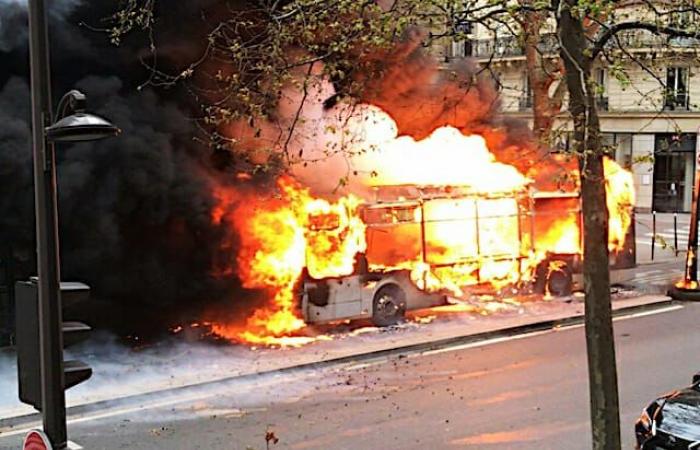In April 2022, the same month, two RATP Bluebus battery-electric buses caught fire spontaneously. Although there were no injuries in these two events, this prompted a technical investigation by the BEA-TT which delivered its conclusions on October 30, 2024. TRM24 was able to go through them, here is a summary. TRM24 had already mentioned a series of fires which affected battery-electric buses.
Analysis of Bluebus telemetry data during the BEA-TT investigation shows that for the fire of April 4, 2022 “ the self-discharge current had increased rapidly, from 50 mA to values in the 150-200 mA range. This increase did not trigger an alarm because the data processing was carried out via an algorithm based on average values and not peaks. ».
The analysis for the fire of April 29, 2022 is even more worrying and revealing of the dangers of lithium-ion batteries. In this case “ the self-discharge current had tended to increase in the days preceding the fire, without reaching the alarm triggering threshold. » In the technical literature, it is reported fairly consistently that lithium-ion batteries of the NMC, NCA and LMP type can have spontaneous fires well after the occurrence of accidents or incidents on the vehicle. It is for this reason that the ministerial decree of August 3, 2018 requires the quarantine (and associated monitoring) of any battery-powered coach or bus that has suffered an accident or has suffered an impact likely to damage its accumulators.
The latest BEA-TT report above all brings a number of improvements to be made for the safety of people and emergency services. Its 1era Recommendation calls for an amendment to the ECE R100-3 regulation so that battery pack monitoring devices are able to alert the driver in the cockpit when the battery pack temperature exceeds a critical value. The BEA-TT notes in particular that the self-discharge criterion (possible warning sign of an internal short circuit, precursor to the start of a fire) poses a difficulty in defining the relevant threshold for triggering the alarm. It must not be neither too low because certain phenomena of this type are completely normal and this would have serious consequences on the availability of vehicles, nor too high because a proven failure would not be treated correctly and would not make it possible to identify an early defect such as 'an intercell short circuit. (…) ».
Regarding telemetry, the BEA-TT suggests that manufacturers and operators can ensure the transmission, recording, and storage of all operating and operating data that can provide explanatory elements on accidental causes for a period of time. at least 5 days. He asks the Directorate General for Energy and Climate (DGEC) to propose to the UN and the European Union to incorporate these devices as part of the approval of new vehicles.
On the cause of the fires, the government site managed by the Ministry of the Economy and Finance, gave the origin as early as 2022 (see http://rappel.conso.gouv.fr/fiche-rappel/17123/Rapex) .
Danger where you least expect it
The BEA-TT was able to study the carcasses of the two buses. The report details the design of the vehicles and highlights the fact that “the passenger compartment is isolated from the battery compartments located on the roof and partly back by stainless steel sheet partitions “. Alas, these precautions were completely in vain: “ Indeed, although the roofs which protect the passenger compartments are made of stainless steel, they were penetrated by the batteries under the effect of heat, probably as a result of a phenomenon of creep of the steel. For the record, the melting temperature of stainless steel is 1420°C, which gives an idea of the temperatures reached during these fires. “. One of the packs having passed through the ceiling just after the evacuation of the passengers! These battery packs fallen to the ground, always dangerous and sources of fires, were also a source of difficulty for the intervention and rescue services when it was necessary to clear the roads afterwards.
In his 4th recommendation, the BEA-TT therefore asks Bluebus to reinforce roof protection to “ allow complete evacuation of passengers safely “. More generally, we can really be concerned about the fire behavior of electric vehicles with composite structures or panels (glass fiber -at VDL- and/or carbon fiber -at Ebusco-). The BEA-TT notes that the battery packs generated a quantity of molten metal projections, with a range of 3 to 4 meters beyond the bus. This could have contributed to numerous serious bodily injuries. What motivates the 5th recommendation of the BEA-TT in order to improve the protection of vehicle exits from any risk of such projections in the event of fire.
Firefighters facing new dangers
The BEA-TT spoke with various departmental fire and rescue services and noted that they were doing their own research and developing their own action methodologies. The Vienne SDIS organized several technical days of discussion on interventions on vehicles, particularly electric or gas[1]. But the BEA-TT requires greater coordination and more involvement of state services in its 6threcommendation. It formally requests that the General Directorate of Civil Security and Crisis Management (DGSCGC) of the Ministry of the Interior ensure national management of the distribution of research in the fight against fires of new energy vehicles (in particular electric and hydrogen).
The dangers are unprecedented: toxic fumes, difficulties in evacuating wrecks which are always dangerous (risk of electric shocks and/or resumption of fires). Removing the charred buses took 11 hours in the first case, then 6 hours in the second case. The report warns of a danger specific to battery-powered vehicles: “ it is almost impossible to quickly and completely extinguish a fire from this type of lithium-metal-polymer battery. New outbreaks of fire were also noted during the evacuation of the carcass and the cleaning of the road at the site of the François-Mitterrand library fire. “. Luckily, the professionalism of the two RATP bus drivers made it possible to alert the emergency services with the relevant information for the two interventions allowing “ workers to work safely, particularly with regard to protection against pollutants emitted and projections of molten metal particles, or even explosions ».
The BEA-TT wishes, as a precaution, in its 7th and final recommendation, that the eCall automatic emergency alert device (Regulation 2015/758 EU) transmitting the geolocation of the vehicle, its type, its category, its serial number and its mode of propulsion be extended to all categories of vehicles and not just cars and light commercial vehicles. He asks the DGEC to take steps with the European Union in this regard.
To view the document in its entirety: https://www.bea-tt.developpement-durable.gouv.fr/paris-avril-2022-feus-de-deux-bus-electriques-r323.html
[1] SDIS86 has published an IUV memento which can be purchased via this address: https://www.udsp86.fr/produit/memento-iuv-francais/
This may (also) interest you


The latest articles by Jean-Philippe Pastre (see all)








